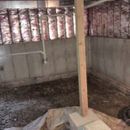Insulate “crawlspace”
I put crawlspace in quotes because this is more of an unfinished basement with dirt floor. The joists above range from 7-10′ above grade. The floor slopes 5′ in the middle. I currently have no plans to finish the basement.
The house is in Zone 6. I want to make it more cost effective for heating and keep the moisture controlled.
My plan is as follows:
1. put 15-20 mil plastic over the current plastic sheets which has been walked on and is now covered in holes. Re-attach to foundation and seal using tape.
2. Glue 2″ EPS or XPS sheets to the poured concrete foundation using foam adhesive. Tape the joints. leave 3″ gap at top of concrete wall.
3. screw 2″ polyiso foil faced rigid foam to the studs over the foil faced batts seen above the concrete walls. Do the same in rim joists.
4. install a dehumidifier.
I am confused by the insulation in the ceiling with kraft paper facing in, but there are heating vents so I imagine I would leave those alone. There is no current mold problem as I assume the original plastic on the floor was in good shape for most of its life.
Only other issue is fire rated covering. I am not sure how to handle that. I don’t want to use wallboard here.
Am I missing anything?
GBA Detail Library
A collection of one thousand construction details organized by climate and house part










Replies
Picture didn't attach...
try again
James,
It's a good idea to cover rigid foam with a layer of drywall, for fire safety reasons. The drywall is also a code requirement in most areas (although individual code officials may have different interpretations of code requirements, so you can always call up your local building department to get more information on this issue).
Note that the exposed kraft paper on the ceiling is also a fire hazard. You may end up deciding to remove the ceiling insulation to reduce the fire hazard.
If you do a good job with the details you describe, everything will stay dry (including the drywall).
To meet minimum code requirements, you should bump up the thickness of the rigid foam that you plan to install on the concrete walls. The minimum requirement in Zone 6 is R-15. Remember, too, that air sealing work always comes before insulation work -- so pay attention to air sealing.
If you are planning to glue rigid foam to the concrete walls, you'll need (a) to use foam-compatible adhesive, and (b) to devise a way to apply pressure to the sheets of rigid foam as the adhesive sets.
You may be able to get away without the dehumidifier. After performing the insulation work, monitor the area -- if it's dry, skip the dehumidifier.
There is standing water in the lower part of the space. It is below a layer of rock/gravel so the plastic won't sit in a puddle and gravity feeds away through a french drain to daylight a few hundred feet from the house. I was going to install a sump to drop the water a few more inches, but after several hours of pumping I saw very little change in the water level, so I think leaving it gravity fed is best, and since I can keep the level below the plastic I don't see a compelling reason to add the sump.
I was inspecting my concrete walls, and there are lots of intrusions and protrusions from the pour, primarily at the seems of the forms. The walls are not flat. While the intrusions probably aren't an issue, any protrusions will definitely impact the contact with the foam. How do people clean that up? I figure maybe Ill take a pneumatic chisel or hammer drill with a chisel and just knock them down. Seems easier than cutting matching holes in the foam.
I am hesitant to remove any insulation as the space, while heated, is colder than the house by 20 degrees. Plus, hanging drywall down there will be a a total pain, but I get you on the fire issue. The house was like this when I bought it, BTW. I did add several smoke and CO detectors, wasn't one anywhere in the house.
James,
You could use Thermax (assuming your code enforcement office will go along). Dow has a detail showing the Thermax combined with sprayed open cell foam. So maybe you could do something similar by using a layer of EPS (possibly reclaimed) and a top layer of Thermax.
Perhaps Dana will comment since he seems to know this topic really well.
James,
Once you insulate the walls of your basement, the area won't be as cold. But I understand why you may still want to leave the fiberglass in the ceiling. It's your choice -- although I advise you to pay attention to fire safety.
Whether the bumps on your concrete matter is a judgment call. Small bumps aren't necessarily a problem -- just bang the rigid foam as you install it, and the bump will create a matching dent in the rigid foam.